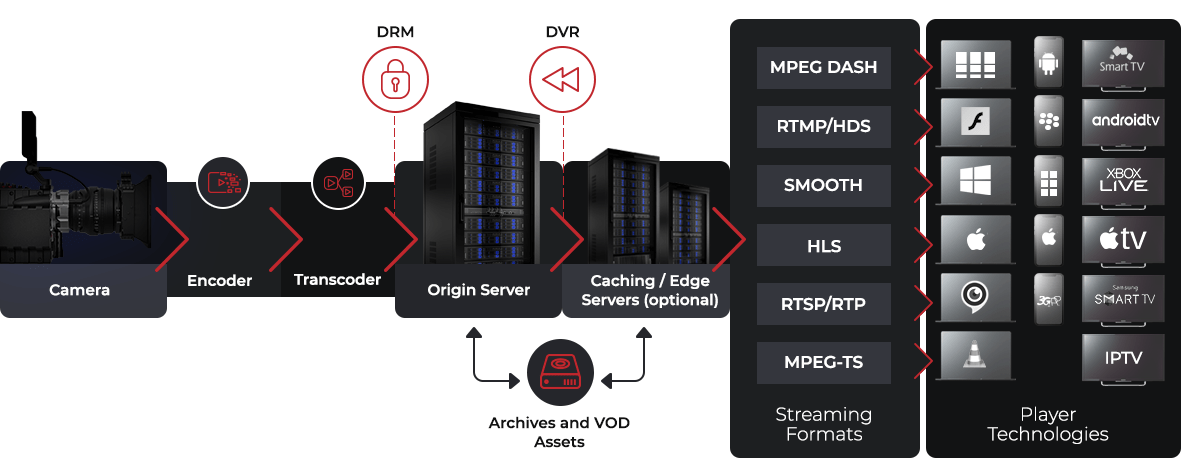In the times of pandemic when healthcare resources are stretched to the breaking point, telehealth technology swoops in with the promise of scalable and cost-effective care delivery. With the ability to connect remote patients with the right specialists in a timely manner, telemedicine video conferencing drives the shift towards patient-centered, value-based care.
But telehealth will lose much of its benefit if video quality is low. Not only jitters and delays can ruin a patient experience and hamper adoption, but low-quality video can undermine the accuracy of diagnostic assessment and impact health outcomes.
There are a lot of pieces to a high-quality video conferencing puzzle. So, let’s dive right in to see how to deliver the clarity of in-person visits for your telehealth platform.
Latency engineering
Latency, or delay, is the time required for audio and video signals to travel from the sender to the receiver. For some telehealth video conferencing solutions used in critical medical settings, latency requirements are extremely stringent — think telerobotic surgery, cardiac patient monitoring, telestroke applications, and more.
The thing with latency is, though, that it is introduced throughout the entire video delivery chain from acquisition to coding to transmission to reproduction. The logical solution is to take a comprehensive approach and optimize delays each step of the way.

Video transmission delay sources
By starting with latency-driven architecture design and moving to industry-standard encoders and ultra low latency streaming protocols like chunked CMAF and MPEG-DASH, you can significantly improve your telemedicine solution QoS. Best practices also include implementing multi-CDN and peer-to-peer CDN setups.
How we can help
Staying on the cutting edge of real-time communication technology since its inception, we have accumulated solid expertise in building reliable and highly scalable video conferencing solutions. Enhance your practice with robust telemedicine capabilities from video-based direct patient care to peer-to-peer consultations to staff education.
Tell us more about your video conferencing software development needs.
Adaptive bitrate streaming
One of the things that smooth video conferencing relies on is dependable connectivity. However, there are many factors that play their part in a stable high-speed Internet connection — a user’s location, fixed or mobile networks, multiple users on the same network, etc. These bandwidth limitations can have a devastating impact on the perceived video quality. A virtual consultation open to interruptions from video buffering and audio chopping can hardly be deemed a consistent telehealth experience that patients expect.
Adaptive bitrate streaming, or ABR for short, helps meet the stringent QoS constraints for quality video conferencing on any connection. By dynamically adjusting the bitrate to changing network conditions, ABR enables the optimal viewing experiences at any given moment of time. To do that, a media server creates different streams with different bitrates and resolutions and then sends the highest-quality stream possible to viewers.

Adaptive bitrate streaming
Error control
Another reason that can degrade the quality of real-time video streaming is errors introduced during data transmission. These errors can result from network congestion, packet losses, and route failures, and other QoS problems.
To handle the challenges of unreliable communication channels, different error control methods are used. One of them is forward error correction (FEC) — a channel coding technique that improves reliability by adding redundancy to the transmitted data and enabling proactive recovery of lost packets. Automatic repeat query (ARQ), used separately or in addition to FEC, also serves to ensure error control. In ARQ, a receiver automatically requests a transmitter to resend the packet if an error was detected.

Forward error correction
Real-time QoS monitoring
In telemedicine, staying on top of the quality of service is vital to ensure reliable and predictable communications even in emergency cases. Continuous monitoring of critical parameters helps gain a real-time view of user experience and proactively pinpoint any performance issues before they ruin QoE for patients.
Implementing continuous QoS monitoring as part of your WebRTC application development project allows you to keep in check the following parameters:
- Network capacity
- Latency and jitter
- Round trip time
- Pixelization and blurring
- Dropped frames, etc.
To maintain reliable performance of your video conferencing solution, you can set thresholds for any metric to receive alerts when quality is degrading. These alerts can trigger automatic diagnostic tests to find the root cause and fix the issue.

Continuous video QoS monitoring
End-to-end testing
Quality assurance can never be an afterthought, especially for mission-critical telemedicine video conferencing systems. Meticulous testing is a must to confirm performance, reliability, and usability of your solution.
From UX design to backend architecture to APIs and integrations, a comprehensive testing approach needs to cover all application layers while taking into account video conferencing specifics. In addition to automated and manual video and audio quality testing, synchronization testing is needed to ensure that video and audio streams are delivered simultaneously in real time for quality patient care.
Rigorous load testing allows you to meet peak demands with confidence and scale your solution to millions of concurrent users. With that in mind, it’s equally important to ensure that patients can enjoy high-quality video-based care on any device of their choosing, hence your strategy needs to include cross-platform testing as well.
Wrapping up
Video quality can make or break your telehealth video conferencing solution. Delays, frame jitters, out-of-sync video and audio can make all the difference between high-quality patient care and lost trust in new technology. From latency-optimized architectures to real-time QoS monitoring to end-to-end quality assurance — a lot goes into ensuring reliable video quality but the rewards are worth it.



























